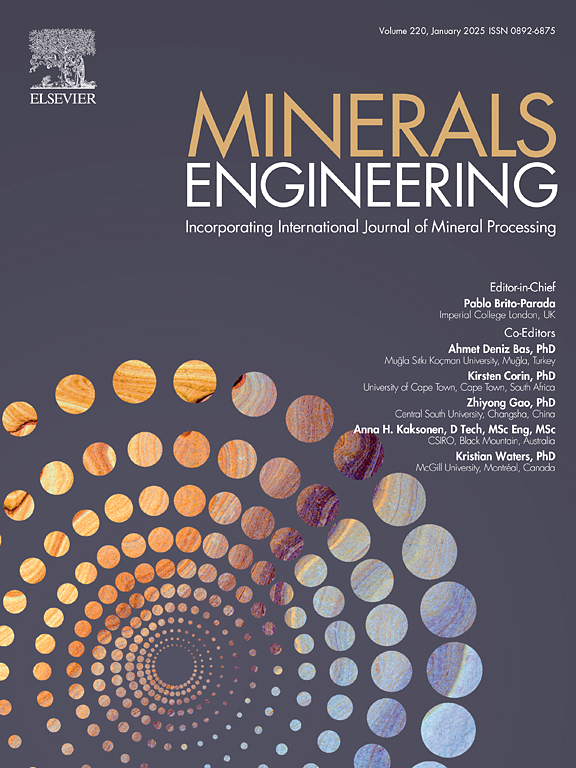Enhanced hydrogen-based reduction of hematite by bastnaesite: Kinetics and microstructural evolution mechanisms
IF 5
2区 工程技术
Q1 ENGINEERING, CHEMICAL
引用次数: 0
Abstract
To investigate the hydrogen-based reduction mechanism of the polymetallic Bayan Obo hematite, this study utilized pure hematite and bastnaesite minerals to conduct fundamental kinetic research on the hydrogen reduction process of hematite influenced by bastnaesite, Isothermal reduction experiments were conducted under controlled hydrogen atmospheres, followed by kinetic modeling to elucidate reaction parameters, while phase and microstructural evolution were revealed through XRD, SEM, and BET analyses. Kinetic models were applied to compare the hydrogen reduction kinetics of pure Bayan Obo hematite and its mixture with bastnaesite, highlighting the promoting effect of bastnaesite on the reaction rate. Results show that bastnaesite accelerates the reduction process and reduces the apparent activation energy (Eα). X-ray diffraction (XRD), scanning electron microscopy (SEM), and Brunauer-Emmett-Teller (BET) surface area analysis were employed to examine phase transformation and microstructural evolution process. XRD revealed that bastnaesite promotes the efficient conversion phenomenon of hematite to magnetite. SEM images showed that bastnaesite enhances crack and pore formation and development in hematite particles. BET analysis confirmed that bastnaesite increases the surface area of the reduction products. These results not only reveal the promoting effect of bastnaesite on the hydrogen-based reduction of hematite, but also suggest its potential application in low-carbon metallurgical processes involving rare earth minerals. With hydrogen-based reduction technologies advancing, rare earth minerals are expected to play a key role in efficient, cleaner steel production, contributing to the green transformation of metallurgy.
氟碳铈增强赤铁矿氢基还原:动力学和微观结构演化机制
为了研究巴彦鄂博多金属赤铁矿的氢基还原机理,本研究利用纯赤铁矿和氟碳铈矿对受氟碳铈矿影响的赤铁矿氢基还原过程进行了基础动力学研究,在可控氢气氛下进行等温还原实验,建立动力学模型阐明反应参数,同时通过XRD、SEM、和BET分析。采用动力学模型比较了纯巴彦鄂博赤铁矿及其与氟碳铈矿的混合氢还原动力学,突出了氟碳铈矿对反应速率的促进作用。结果表明,氟碳醚加速了还原过程,降低了表观活化能(Eα)。采用x射线衍射(XRD)、扫描电子显微镜(SEM)和布鲁诺尔-埃米特-泰勒(BET)表面积分析来考察相变和微观组织演变过程。XRD分析表明,氟碳铈矿促进了赤铁矿向磁铁矿的有效转化。SEM图像显示,氟碳铈矿促进了赤铁矿颗粒中裂纹和孔隙的形成和发育。BET分析证实氟碳醚增加了还原产物的表面积。这些结果不仅揭示了氟碳铈矿对赤铁矿氢基还原的促进作用,而且表明了其在稀土矿物低碳冶金工艺中的潜在应用前景。随着氢基还原技术的进步,稀土矿物有望在高效、清洁的钢铁生产中发挥关键作用,促进冶金的绿色转型。
本文章由计算机程序翻译,如有差异,请以英文原文为准。
求助全文
约1分钟内获得全文
求助全文
来源期刊

Minerals Engineering
工程技术-工程:化工
CiteScore
8.70
自引率
18.80%
发文量
519
审稿时长
81 days
期刊介绍:
The purpose of the journal is to provide for the rapid publication of topical papers featuring the latest developments in the allied fields of mineral processing and extractive metallurgy. Its wide ranging coverage of research and practical (operating) topics includes physical separation methods, such as comminution, flotation concentration and dewatering, chemical methods such as bio-, hydro-, and electro-metallurgy, analytical techniques, process control, simulation and instrumentation, and mineralogical aspects of processing. Environmental issues, particularly those pertaining to sustainable development, will also be strongly covered.
 求助内容:
求助内容: 应助结果提醒方式:
应助结果提醒方式:


